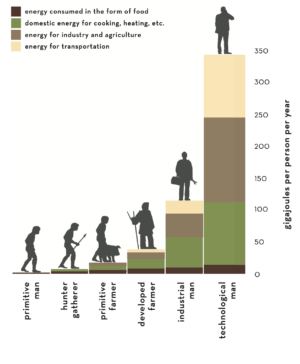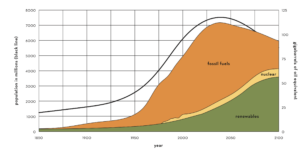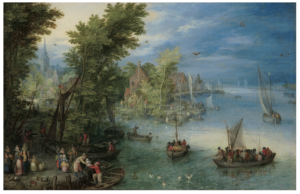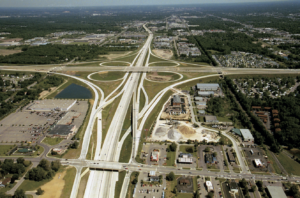Energy and Transition
The new threshold for green building is not just low energy, it’s net-zero energy. In The New Net Zero, sustainable architect Bill Maclay charts the path for designers and builders interested in exploring green design’s new frontier net-zero-energy structures that produce as much energy as they consume and are carbon neutral.
The following is an excerpt from The New Net Zero by Bill Maclay. It has been adapted for the web.
Energy is our fuel and foundation, the source of power for our civilization. It is ubiquitous in our patterns of daily living. It allows food to be produced and goods to be transported. It powers our cars, buildings, and industries and is essential in the creation of the materials we consume, from food and consumer goods to building products and technology. Everything, in fact, can be seen as energy in one form or another.

FIGURE 1.1. As new energy sources have been discovered, the amount of energy each person consumes has increased dramatically from primitive hunter-gatherer societies to modern civilization.
Look back in time, and the story was the same. Energy sculpted our settlement. patterns. It was the force behind the birth of modern society. Short periods of human history may have been dominated by politics, war, individual demigods, or major climate upheavals, but the major factors shaping the evolution of civilizations stayed the same: energy, its form, its availability, and its cost.
Today the energy sources we rely on to fuel our society can be divided into two simple categories: nonrenewable and renewable. Nonrenewable energy refers to finite energy sources, those that, once exhausted, cannot be replenished. Nonrenewable energy sources include two major categories: fossil fuels such as coal, natural gas, and petroleum and radioactive fuels used in nuclear technology, such as uranium. Nonrenewable resources are currently being consumed at a rate much faster than they can be replenished by nature, and as resources decrease they will become too costly to harvest. Renewable energy refers to energy sources that renew through natural forces and processes, such as sun, wind, tidal waves, hydro, biomass, and geothermal energies. There is enough potential energy from renewable energy sources to cover all global energy needs thousands of times over.
Where does the concept of net-zero fit into this larger context of energy? It’s important to dispel a common misunderstanding. “Net-zero” does not mean using no energy. That’s impossible in our modern, high-tech world, just as it was impossible in ancient times and throughout the evolution of all life and the universe. Rather, “net-zero” refers to producing, through renewable sources, more energy than is consumed— or becoming a net renewable energy producer. This new term broadly indicates a future without fossil fuels.
To most of us, net-zero seems like an intriguing, new idea—a new paradigm for our energy future, one that functions on renewable resources only. But the reality is that with the exception of the historically brief fossil-fuel era in which we live today, humans have always lived in a net-zero world. It is interesting how short our memories are.

FIGURE 1.2. World energy consumption has increased rapidly with the rise in human population in the fossil-fuel era.
Anyone reading this book will likely already know, though, that the fossil-fuel era had a profound impact on both civilization and the planet. To understand why, we need to understand that energy is to civilization what food is to biological organisms. If there is food readily available to biological organisms, the organisms grow and their population grows. We can all remember this fact from middle-school biology: if rabbits proliferate, so, too, do the foxes that eat them.
The same holds true for energy sources and the humans that depend on them. Only the story can get a bit more complex. The more energy we have, the more our populations grow, and the more energy each one of us uses. It now takes ten times more fossil-fuel energy than solar energy (as in photosynthesis) to feed us when you include the fertilizers, tractors, irrigation, transportation, processing, packaging, refrigeration, cooking, and all of the other energy-consuming aspects of human food production. Over time, we’ve used more and more energy to produce and transport goods, services, and information. As figure 1.1 shows, our energy use per person has grown as we have evolved.
As energy became relatively easier to find and use, more people were fed with less effort, driving population growth and providing other human conveniences. Figure 1.2 shows the correlation in the historical growth of global energy consumption and population over the past few millennia, including the rapid increase in growth of energy and population in the fossil-fuel era.
The future population, quality of life, and wealth of our society will also likely relate to where our energy comes from, how it is transported to us, and ultimately how much it costs. Inexpensive energy not only fuels population growth but boosts the accumulation of wealth by society, businesses, and individuals. If energy costs rise, it will impact every aspect of society, from the production and transportation of goods to population and settlement patterns.
Even when a society has the opportunity to transfer from a more expensive energy option to a less expensive one, the development of new infrastructure and the repatterning of human activities cause significant societal pressures and temporary additional costs.

FIGURE 1.3. Humans have always used diverse forms of renewable energy, including windmills, sail power, and water mills, for cooking, comfort, and production of goods and transportation.
The cost of an energy resource is related to its density and ease of collection, extraction, and transportation to where it is used. Fossil fuels are solar energy converted into plant materials and then compressed under pressure. Thus oil, coal, and natural gas contain significant energy in a relatively small volume of material that can be easily transported. Collecting solar, wind, and water power require large areas of land to collect the less concentrated forces of the sun, moving air, and water. We are arriving at a point where even fossil fuels are becoming more difficult and therefore costly to access. But the predominant view remains that nonrenewable resources are much less expensive than renewable energy because they are relatively easy to capture in comparison.
Through constant innovation, we have always found better ways of using energy to serve our daily purposes. Consider the advent of the wheel, sail power, and water power; the domestication of animals; and the creation of steam engines, internal combustion engines, telephones, and computers. All these developments allowed humans to harness power in new ways. While many people believe that future innovation alone can solve our problems, including energy and climate change, the answer may not be evident until it is too late. Innovation will continue to be a critical factor in shaping human civilization, but selecting the appropriate energy source is equally or likely more important.
Social traditions can also affect the preference of one energy source over another. In general, social norms resist change, slowing down the transition from one fuel source to another. Today we see this in the resistance of big business, politicians, and most of the population to changing our primary energy source to renewables. Renewables are new and different, and people are understandably cautious. However, there are some cases where social pressures can hasten energy transitions. As an example, the Chinese government has been very aggressive in increasing the amount of their energy supply that comes from renewables, as they see the enormity of the global energy challenge and the advantageous position this transition might allow.

FIGURE 1.4. Sprawl and highway-side development in the fossil-fuel era.
Our relationship with renewable energy is long indeed. As hunters and gatherers, humans used the solar energy stored in biological organisms for food, shelter, clothing, and all other material goods. Our most primary application of energy was the transference of power in the human body: we were fueled by food. Over time we began to develop additional ways of deriving energy from the environment, first with fire, which allowed the stored solar energy in wood to be used for cooking, warmth, and the production of goods. Technological innovations paralleled this growth in energy use. The development of tools in the Stone Age improved the efficiency of hunting.
The next major energy innovation came in the Neolithic revolution, which saw a major transition from hunting and gathering cultures to agriculture and settlement through the domestication of plants and animals. This innovation caused an enormous transition in lifestyle. Society could for the first time produce a surplus of food to store and trade, allowing for increased social complexity and the first population explosion on the planet. While the Neolithic revolution reached parts of the world at different times, archeological data of plant and animal domestication tell us that it started around 10,000 BC and continued to around 3000 BC. During that period the world’s human population grew astronomically: before the Neolithic revolution it had fluctuated between 5 and 8 million, but by around 4000 BC it had grown to 60 to 70 million.2
The need for transportation spurred further innovations in renewable energy. Humans used newly domesticated animals to carry goods, allowing for trade over longer distances. The development of the wheel spurred greater use of domesticated animals, and primitive boats soon made transport by water more efficient than transport overland. Later sail-powered boats allowed for even larger volumes of goods to be transferred over greater distances with less energy.
The way we harnessed renewable energy to meet our needs and desires grew more and more diverse. Industry arose with the fabrication of stone and metal tools and weapons and expanded to the development of water mills and windmills to grind grain and produce textiles. Each of these innovations offered increased efficiency and levels of production that stimulated wealth and human population growth. In fact, renewable energy fueled our world until about the mid-nineteenth century, when nonrenewables took over. First came coal, surpassed by oil in the 1950s. Today our world runs for the most part on oil, natural gas, and coal, with smaller percentages of nuclear power and renewables.
